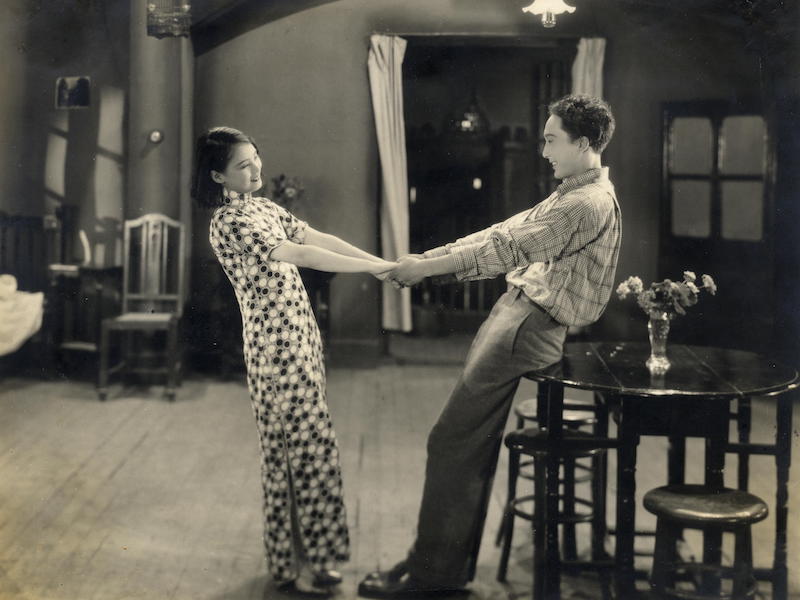FEN DOU
[Struggling]
Dongshan Shi (CN 1932)
The Chinese film Fen dou (Struggling) was considered lost for decades. The studio that produced it, United Photoplay Service (UPS, also known as Lianhua Film Studio), was established in 1930 with the financial aid of the ruling Kuomintang (KMT, the Nationalist Party). Modelled upon L’Unione Cinematografica Educativa, UPS films were supposed to promulgate the New Life Movement. The movement promoted the image of modern youth as athletically fit, sexually attractive, yet morally reserved, who would serve as mechanical components in the larger national production. For example, in the film’s opening sequence, the two protagonists, Zheng (played by Djen Jon Lee/Zheng Junli, 1911–1969) and Yuan (Yuan Congmei, 1916–2005), are introduced as parts of an immaculate machine-like environment. At home they wear overalls, American-styled sports outfits, or well-tailored shirts to accentuate their athletic bodies. Meanwhile, the leading female character, Swallow (16-year-old Chen Yanyan, 1916–1999), was a performer of the famous Bright Moon Ensemble, which featured teenage girls singing patriotic songs in swimsuits and other athletic costumes onstage.
The Japanese military invaded Manchuria on 18 September 1931, and then Shanghai on 28 January 1932. In response, filmmakers and dramatists, including Shen Xiling (1904–1940), Tian Han (1898–1968), Xia Yan (1900–1995), and Yang Hansheng (1902–1993), initiated a Marxist debate on cinema, and established the Chinese League of Left-Wing Dramatists (CLLD) under the leadership of the Communist Party of China. Left-wing cinema, however, was sometimes criticized as being didactic, and their use of the kind of montage proposed by Vsevolod Pudovkin, with a largely static camera, was considered too intellectual.
In response, screenwriter Huang Jiamo (1916–2004) and avant-garde writer and filmmaker Liu Na’ou (1905–1940) urged filmmakers to pay attention to aesthetics, rhythm, and the relationship between sense-perception and reality. They aligned themselves closely with the works of the Europeans René Clair, Léon Moussinac, and F. W. Murnau. Huang and Liu believed that the cinema has the power to put spectators into an affective state, to feel as though they had once been there. The resonance between a spectator’s sensory faculties/perception and the film’s emotional milieu would then enable a political message to be instilled into their physical being as a new mode of consciousness.
Director Dongshan Shi (1902-1955) was a member of the CLLD. Struggling demonstrates Shi’s belief in Marxism in two respects. First, the narrative is structured upon the dialectical “struggle” between two friends: Zheng, a courageous, handsome, manly, romantic working-class man, and Yuan, another working-class man, who is corrupted by middle-class craving for money and sexual desire, and bullies his own kind but turns frail when he is called to arms to fight the Japanese. These two young men fall in love with the same young woman, Swallow, who has been abused by her stepfather. Zheng elopes with Swallow and they move to the city, only to be found by Yuan. The two friends get into a fight and are arrested. Eventually, the Japanese invasion unites the two young men and they volunteer to fight, leaving Swallow in the country to wait for their return. Secondly, the architecture of the old house in the beginning of the film verticalizes the class struggle between the feudal class (Swallow’s stepfather) on the top floor, the working class on the middle floor, and the intellectuals-turned-farmers on the ground floor.
Yet, as a commercial UPS film under KMT censorship, Struggling embeds such sociopolitical struggles within a romantic plot, with the lustrous cinematography of Zhou Ke. Zhou uses a mobile camera that invokes the camerawork in Murnau’s films and the framing techniques, composition, and editing devices of Pudovkin’s montage. The camera often navigates fluidly around the characters, so that the spectator can be immersed in the scene with them. At other times the camera dollies away from the characters, thus following an early-20th-century Shanghai aesthetic principle: to give the characters air (room) to make visible their interdependent relationships. For the film, Zhou built a three-story-high structure, so that the camera could move vertically along a staircase, which functions as narrative punctuations in the first section of the film. In addition, Zhou employs a telephoto lens, which not only glamorizes the lead actors, but also allows him to use mathematically and rhythmically precise rack-focus photography to generate sensual stimulations and emotional poignancy.
The aesthetic sophistication of Struggling is unmatched by most of the extant films from Shanghai during this period. It conveys Marxist ideas by using aesthetically captivating formal devices. Shi would later become famous for his epic post-war melodramas in the late 1940s, and Zheng would also become one of the most accomplished Shanghai filmmakers and theorists in the 1940s and 1950s. Shi received an award at the 1951 Karlovy Vary International Film Festival, though he tragically committed suicide during a large-scale purge against cultural theorists and critics in 1955.
Victor Fan


regia/dir, scen: Dongshan Shi.
photog: Zhou Ke.
cast: Djen Jon Lee/Zheng Junli (Zheng), Yuan Congmei (Yuan), Chen Yanyan (Yan [Rondinella/Swallow]).
prod: United Photoplay Service/Lianhua Film Studio, Shanghai.
première: 29.11.1932 (Shanghai).
copia/copy: DCP, 85′; did./titles: CHI, subt. ENG.
fonte/source: China Film Archive, Beijing.




